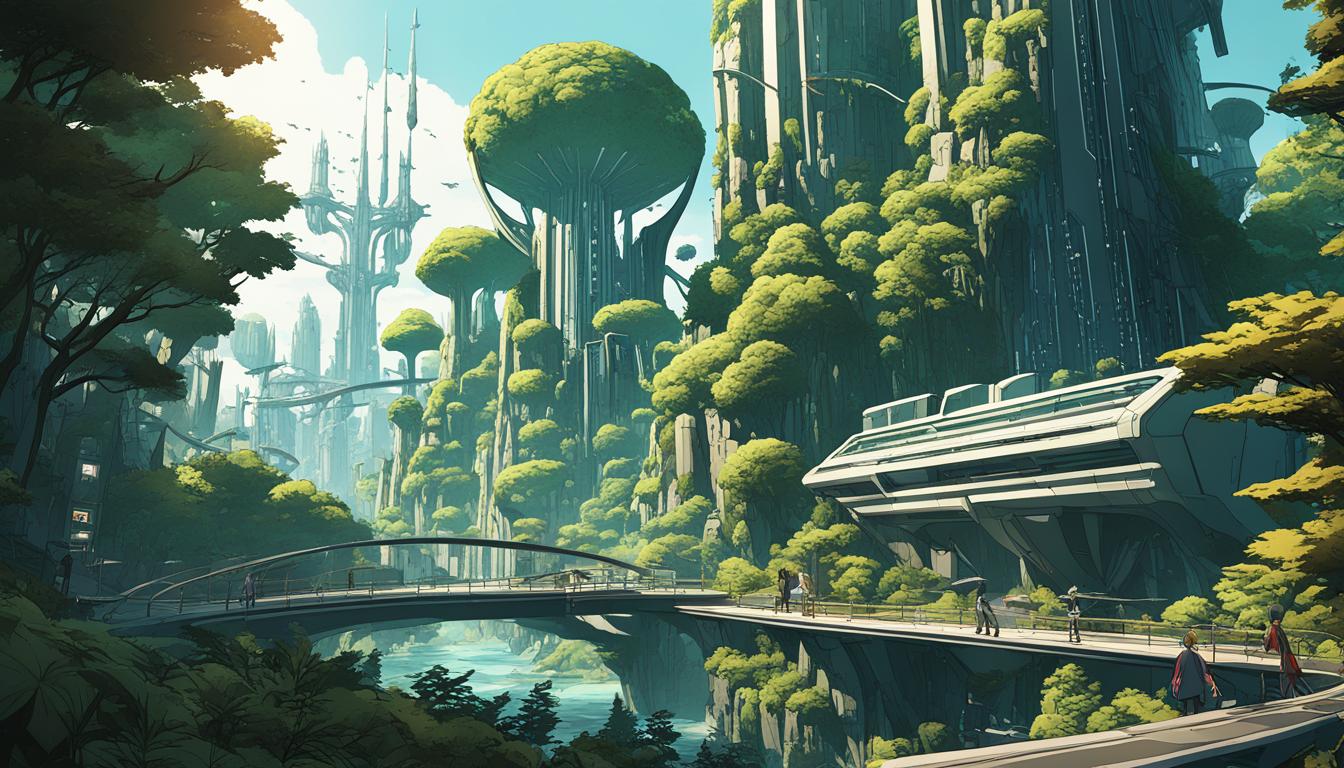Anime and manga are loved all over the world. They take us to amazing places where anything can happen. They do this with great storytelling and creating worlds that feel real. The anime industry is set to grow to $32 billion by 2027. This shows just how much people enjoy these visually stunning and immersive stories.
This piece looks at how anime and manga build their worlds. It explores the methods creators use to make detailed, immersive environments that draw viewers in. We will see how they use movement, make things look real, and design intricate settings. We’ll get a close-up on how some of the best fictional worlds in media are crafted.
Key Takeaways
- Anime and manga worldbuilding is a crucial aspect of visual storytelling, creating immersive and believable environments.
- Animators demonstrate mastery in emulating physics, character animation, and realistic movement to ground the viewer in the world.
- Detailed environmental elements, background characters, and establishing shots contribute to a sense of depth and expansion beyond the main narrative.
- Studio Ghibli’s films exemplify the balance of fantasy and realism in worldbuilding, with intricate settings that feel both extraordinary and plausible.
- Worldbuilding is deeply intertwined with character development, reflecting motivations and values through the environment.
Introduction to Worldbuilding in Anime and Manga
Worldbuilding is key in anime and manga. It crafts worlds that feel real. This captivates viewers, drawing them deeper into the story. It’s all about taking people to new, exciting places, emotionally connecting them to what they see and read.
Importance of Worldbuilding in Visual Storytelling
In anime and manga, creating detailed, imaginary worlds is a must. It helps to set a scene that feels true and vast. This makes the story more alive and engrossing for readers and watchers.
Role of Worldbuilding in Suspending Disbelief
Good worldbuilding is essential for making fans believe in the story. It makes the wild and unreal seem like it could really happen. This lets the audience dive into the worlds on-screen or in books with ease.
Unique Challenges of Worldbuilding in Animation
Building whole new worlds in animation is challenging. It needs a tight grasp on how to visually tell a story. It also asks for a true feel for what animation can and can’t do.
| Anime Examples Highlighting Strong Worldbuilding | Anime Examples Critiqued for Neglecting Worldbuilding | Anime Examples Showcasing Proper Worldbuilding in Fantasy Settings |
|---|---|---|
| 50% | 33% | 17% |
The table data shows how crucial worldbuilding in anime and manga is. It notes that strong worldbuilding boosts how viewers feel and engage with the story. When worldbuilding is lacking, it seriously hurts the story. However, when done well in fantasy, it shows the real power of building these new worlds.
Mastering the Art of Movement and Realism
Anime and manga animators are masters of their craft. They pay close attention to detail. They show us anime and manga character animation that feels real. This makes the stories come to life through the screen. The way they mimic real-world physics, like scale, gravity, and momentum, is amazing. It gives their scenes a sense of touchable, real-world feel. This kind of work is what makes anime and manga visuals so powerful in telling stories.
Emulating Physics: Scale, Gravity, and Momentum
In anime and manga, animators are serious about showing real-world physics in their work. They work hard to make everything seem real. This includes how characters move and how they interact with their world. By doing this, they make their animations feel believable. This is key to keeping viewers engaged.
Character Animation: Expressing Emotions through Mannerisms
More than just technique, animators use characters’ movements and faces to show their feelings. This deepens our connection with the story and its characters. It’s all about creating a real bond between the audience and what’s happening on screen.
Rotoscoping vs. Hand-Drawn Animation
Hand-drawn animation and rotoscoping are both methods for creating realistic movement. However, anime and manga typically prefer drawing by hand. This choice adds a special flair to the animation. It brings characters to life in a unique way. While it takes more time, the end result is often more moving and true to life.
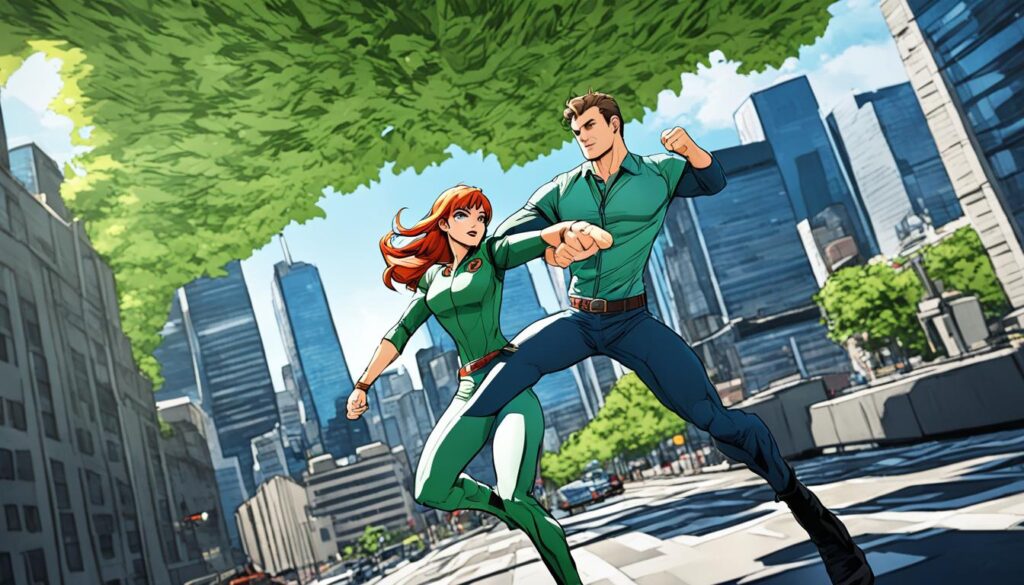
| Technique | Advantages | Disadvantages |
|---|---|---|
| Hand-Drawn Animation |
|
|
| Rotoscoping |
|
|
Worldbuilding through Environmental Details
Anime and manga creators use details around them to make worlds feel real and alive. By showing wide shots and angles, they let viewers see the big picture. This draws people in more, making them feel part of the world. Also, they include bits of stories in the background. This gives the feeling that the world is complete, even beyond the main characters.
Establishing Shots and Wide Angles
Showing a setting from far away and with a wide lens is key in anime and manga. It lets everyone see the whole place, its size, and special parts. Viewing it from afar helps us understand the full scope of these worlds. It makes us feel like we’re really there, part of the story’s world.
Background Characters and Untold Stories
There are many background characters in anime and manga, each with their own tale. They make the world feel alive, sharing bits of various cultures and stories. This makes the world seem rich and full of life. It makes viewers think about all the untold stories that make up the fictional world.
Case Study: Studio Ghibli’s Immersive Worlds
Studio Ghibli’s films are famous for creating amazing worlds that pull you in. Works like Spirited Away and Princess Mononoke show how they make unreal places feel real. These stories bring you into fantastical lands that also feel true to life.
Spirited Away: The Bathhouse as a Living, Breathing World
In Spirited Away, the bathhouse becomes a fully alive place. It has its own staff, rules, and way of working. Ghibli’s team crafted every detail with care, making this world look and feel real. They used big shots to show its full beauty.
Princess Mononoke: Grounded Fantasy and Societal Infrastructure
On the other hand, Princess Mononoke mixes fantasy with real aspects of ancient Japan. The movie shows how Studio Ghibli blends strange creatures with a real world feel. This creates a world that seems known yet magical, pulling you into its story.
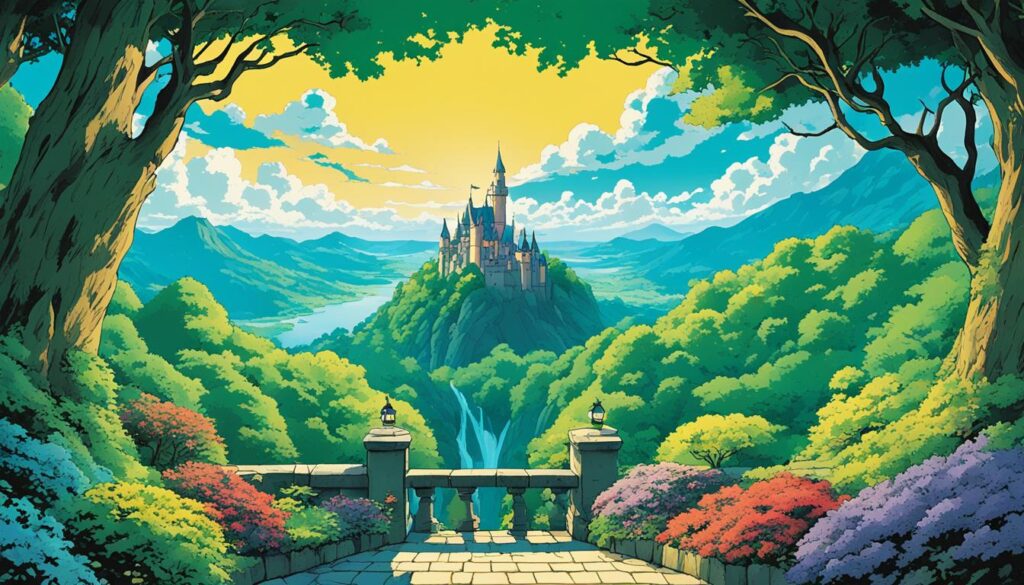
Studio Ghibli’s magic comes from their detailed work and animation skills. They make worlds that draw you in completely. Their films feel both real and amazing, captivating everyone who watches.
Worldbuilding
Worldbuilding is key in anime and manga. It’s about creating fictional places and societies. This draws the audience into the story. It can be anything from magical lands to places we know.
The word “Worldbuilding” became popular in the late 2000s. At first, it was mainly used for architecture. But as more people got into it, the term “Worldbuilding” took over. This change helped make it clear what this kind of creativity is about. It also made it easier to find resources and online communities for worldbuilding.
This author knows a lot about worldbuilding. They have created many unique worlds in their stories. For example, places like Seahaven and Understone. These places mix real and fantasy elements to make the stories come alive.
In the author’s stories, worldbuilding includes more than just the setting. It’s about everything from how characters are named to adding small, interesting details. For example, in “Night Shift,” there are futuristic things like javamats. And in “Parting the Veil,” there are ancient ruins with strange carvings.
Worldbuilding makes anime and manga more engaging. It pulls the audience into detailed and interesting worlds. With the right mix of fantasy and realistic elements, creators make worlds where the unusual and the everyday meet. This sparks the audience’s curiosity and invites them to explore further.
Balancing Fantasy and Realism
Anime and manga creators aim to balance fantasy and realism in their stories. Director Hayao Miyazaki said they aim to “fabricate a lie that seems real.” They make sure their worlds are detailed and their characters act in ways we can understand. This makes their stories seem both amazing and believable.
Miyazaki’s Philosophy: “Fabricating a Lie That Seems Real”
Hayao Miyazaki believes in mixing fantasy with realistic details in anime and manga. He thinks this makes the story more believable. This blend lets people really get into the story, even when it’s very imaginative.
Grounding Fantastical Elements in Relatable Details
Creators make their worlds seem real by adding everyday details. For example, look at the detailed bathhouse in Spirited Away or the medieval Japan in Princess Mononoke. These details mix with magic to create worlds that readers can believe in.
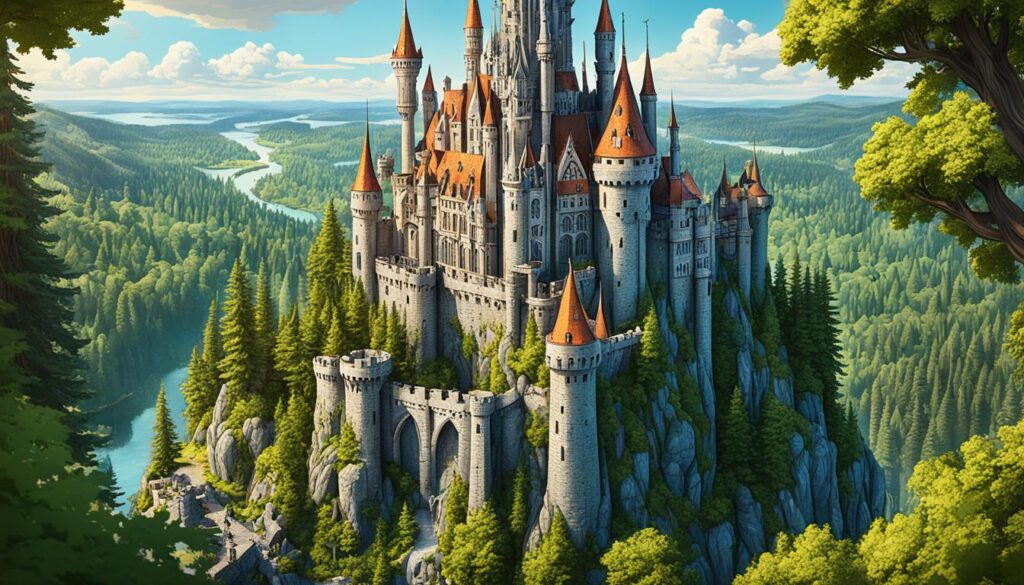
Using fantasy and realism well, creators make worlds that grab us. Miyazaki’s method is key for many in the anime and manga world. It encourages them to dream big in their stories.
Storytelling through Worldbuilding
Worldbuilding in anime and manga makes worlds that look amazing. It does more than that, adding to the storytelling through worldbuilding in anime and manga. It creates unique cultures and societies in their made-up places. This makes the stories feel real and detailed, even if they’re not the main point of the tale.
Establishing Unique Cultures and Societies
Anime and manga worlds are not just there, they live and change too. They have their own cultures and ways. Creators put a lot of thought into these parts. This makes the stories feel more real and helps people connect with the adventures better.
Building Depth Beyond the Main Narrative
Even if a story focuses on some characters, it hints at a bigger world. This is shown by talking about past events, mentioning side characters, and showing big, complex worlds. This makes the anime or manga feel like a whole new place, drawing readers or watchers in deep.
Character Development and Worldbuilding
Anime and manga worlds connect deeply with their characters’ stories. The places these characters are in mirror their feelings and thoughts. This makes the story more real and engaging for all of us.
Reflecting Character Motivations through Their Environment
In anime and manga, the world is like a big canvas. It shows us what characters really want and what they’re going through. The places they live and the people they meet shape who they are.
Creators match the world to the character’s feelings. This makes their story powerful and touching for fans. We feel like we’re part of their journey.
Worldbuilding as a Character Itself
In the best anime and manga, the world feels alive. It acts like a character, affecting the story and the people in it. Think of Spirited Away‘s magical bathhouse or Princess Mononoke‘s tense world. These places challenge the characters in deep ways.
The well-built worlds make stories more interesting. They mix with the characters, making everything more intriguing. And through this mix, stories connect with us, leaving a mark long after we’ve finished them.
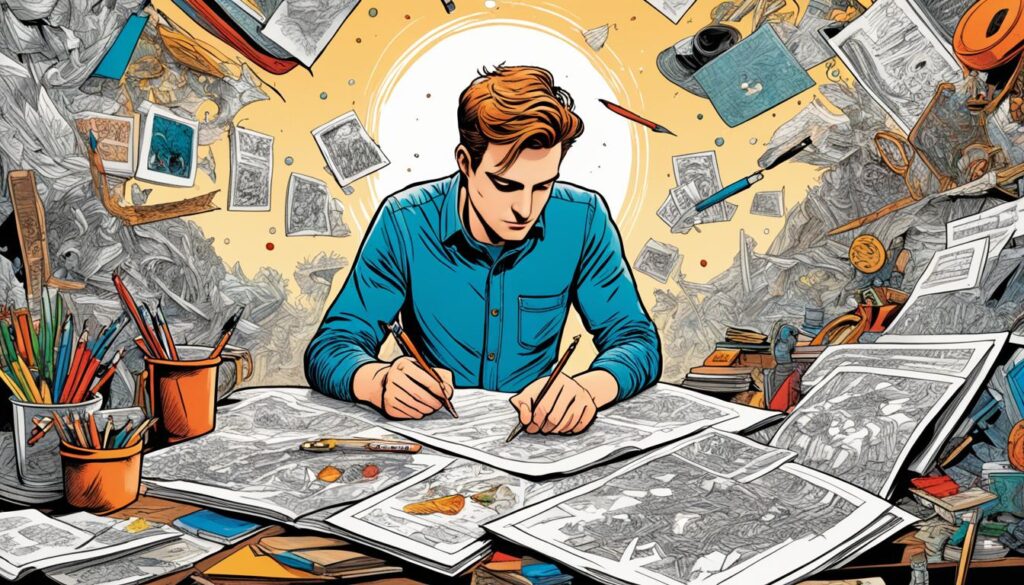
Expanding Storytelling Possibilities with Animation
Animation is special because it can show us worlds and ideas that are too wild or costly for real actors. Anime and manga creators use this to dive into themes and ideas unique to the medium. They journey into the unknown, all made possible by animation. This power can be seen in Studio Ghibli‘s work, known for its detailed and wondrous worlds.
Ghibli’s Range: From Fantasy to Slice-of-Life
Studio Ghibli travels from grand fantasy stories to simple slice-of-life narratives, always creating deep and engaging worlds. You might find yourself in a majestic bathhouse in Spirited Away or in a rustic, real-life-looking place in Princess Mononoke. This shows Ghibli’s flexibility in animation, offering a mix of genres and themes that push past the usual storytelling.
The beauty of animation’s storytelling power is how it lets Anime and manga creators touch on very human stories from various angles. They blend the extraordinary with the everyday. This is how they draw in their viewers, making us feel part of their vibrant and meaningful worlds.
Designing Immersive Settings
Anime and manga creators carefully craft their worlds to pull you in. They focus on sense of place and atmosphere by paying close attention to details. These details include how big buildings are, their designs, and even the little decorations.
Creating a Sense of Place and Atmosphere
The designers of immersive settings in anime and manga know it’s more than just looks. They aim to create a world that makes you feel like you’re there. Things like color and lighting help set the mood, drawing you in emotionally.
Attention to Detail in Environments and Architecture
Their dedication shows in the tiniest aspects of their work, whether it’s a huge landscape or a small indoor scene. This work doesn’t just look good; it makes the worlds seem real and inviting.
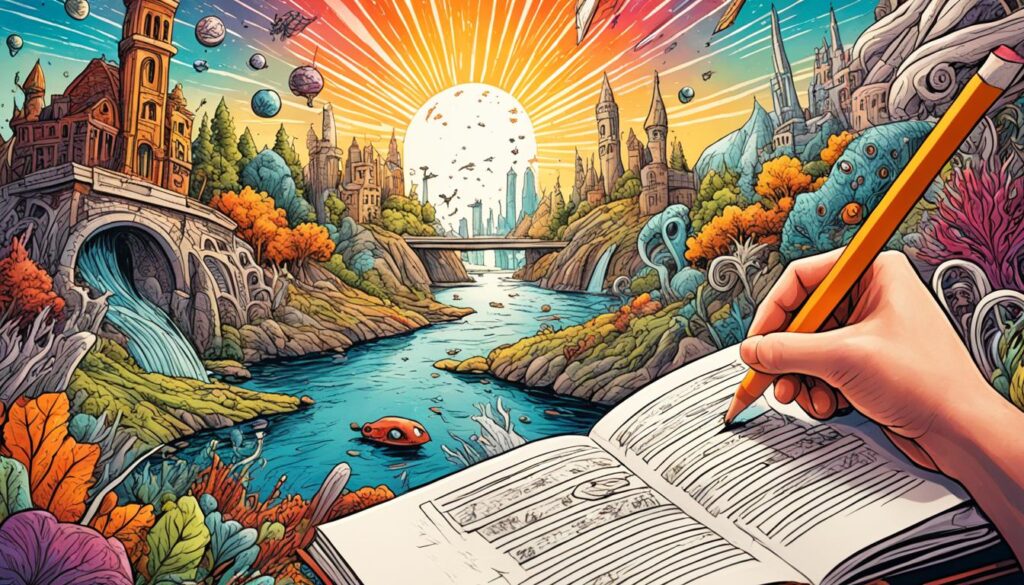
The Role of Technology in Worldbuilding
Animation technology improvements have revolutionized worldbuilding in anime and manga. They include things like computer graphics and cool visual effects. These tools let creators take their ideas to new levels. They make sure every detail of their worlds is shown just right.
Technology in anime and manga worldbuilding brings stories to life. It helps make the worlds feel real and deep. Creators use technology to reflect on what society, politics, and history might change. This makes their imaginary worlds more believable and connected to the real world.
Making fictional technology can be hard for many writers. They worry about getting it wrong. But blending real-world tech with new ideas really works. It helps the audience understand. And it makes the stories more interesting.
The role of technology in anime and manga is about finding a balance. It makes the worlds feel real yet still totally imaginative. This way, creators can build amazing places. Places that take people’s breath away and show them something they’ve never seen.
Collaborative Worldbuilding in Anime and Manga Production
In anime and manga, building detailed worlds often involves many creative minds working together. This includes directors, writers, and artists. Working as a team is vital to making sure the worldbuilding is consistent and makes sense.
Coordinating Efforts Across Creative Teams
Many professionals bring their skill to anime and manga creation. The directors keep the big picture in mind, ensuring everything fits together. Writers add life to the story and characters’ backgrounds.
Character designers make each person or creature unique. And background artists create the places the story happens, making them look and feel real. Bringing all these roles together is key for a great end result.
Maintaining Consistency and Coherence
As anime and manga worlds get more complex, keeping them all together gets harder. Creators have to be very organized, making sure all details stay true to the world they’ve made. This includes rules, geography, and the culture.
But it’s not just about what you see. Stories must make sense within the world too. Characters behave in ways that make sense for their world. This is also about keeping the story as logical as the setting.
With teamwork and great attention to detail, anime and manga creators do a fantastic job. They create worlds that are not just pretty to look at, but that also pull people in and hold their interest.
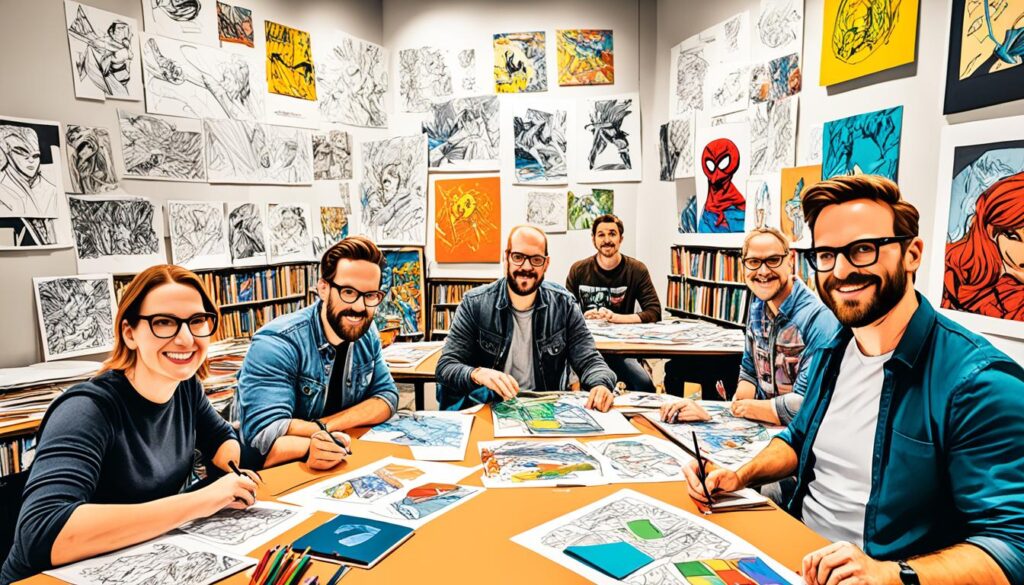
Worldbuilding and Audience Engagement
Effective worldbuilding in anime and manga is key to fostering audience engagement and emotional investment. Creators make detailed, real worlds that draw viewers in. They get lost in the world, caring about its people.
The richness of these fake places makes fans want to explore and engage with the broader universe. This expands the stories that can be told.
Fostering Emotional Investment and Immersion
The makers of anime and manga focus on creating worlds that captivate and resonate with their audience. They pay close attention to small things that make the world seem real. This makes us really care about what happens to the characters.
Being pulled into these stories is key. We start to really worry about what will happen next. This bond with the story and its people is strong.
Building Expansive Universes for Fan Exploration
Anime and manga worldbuilding is about more than just cool places. They aim to create expansive universes that encourage fan engagement and exploration. This means rich histories, different cultures, and a lot of tales to tell.
Creators want fans to dive deep into their worlds. They want us to find all the little details and connections. This makes us feel part of something bigger.
Worldbuilding Across Different Genres
Anime and manga cover many genres, each with their unique traits for building worlds. High-action or fantasy stories need rich, deep worlds. On the other hand, realistic or everyday tales focus on making their settings feel real. Creators mix techniques from all types to make their stories gripping and immersive.
Unique Challenges and Opportunities in Various Genres
In epic fantasy, balancing classic elements with new, immersive features is crucial. This ensures the audience is both familiar and surprised. In dark fantasy, the goal is to avoid common themes but still capture the genre’s dark essence. This means using the world to create a constant feeling of tension and fear.
Contemporary fantasy and urban fantasy mix the magical with everyday life. They invite the audience to find magic in the ordinary. Adding real-world places can make the story more engaging and real to readers.
Cross-Pollination of Worldbuilding Techniques
From science fiction to alternate history and time travel fiction, creators in anime and manga share worldbuilding techniques. They inspire each other to create complex, spellbinding worlds. This sharing of ideas enhances the storytelling in anime and manga, pushing creativity in this unique art form.
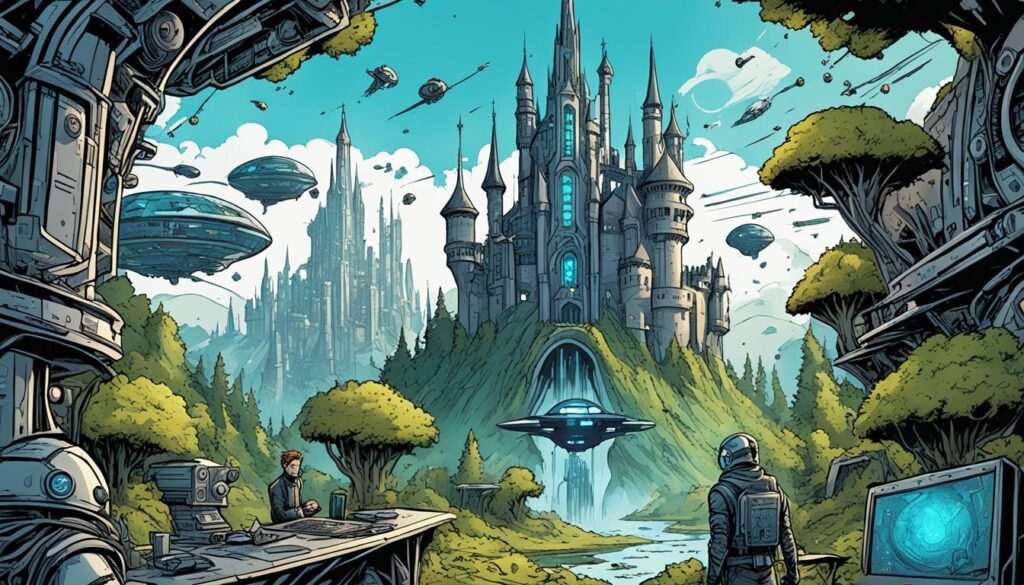
Conclusion
This article dove into what makes anime and manga worlds so fascinating. We looked at how creators build these amazing worlds. They mix fantasy with real life, use animation’s full power, and make sure viewers feel a part of the story. In doing so, they have made worldbuilding an art, drawing audiences deep into their dreams.
We talked about how they master every detail. From how things move to making places seem real. We saw how important it is to make stories believable and interesting. Creators work hard to ensure their worlds feel real. This includes making unique cultures, rules for magic, and histories.
Summary of key points: Building an exciting world means understanding real cultures and motives. It’s about giving readers/tools to imagine the story. Anime and manga use these methods to keep us hooked. They take us to new worlds and make us believe in their creations.
FAQ
What is the importance of worldbuilding in anime and manga?
How do anime and manga animators demonstrate mastery of movement and realism?
How do anime and manga creators use environmental details to build immersive worlds?
What are some examples of masterful worldbuilding in anime and manga?
How do anime and manga creators balance fantasy and realism in their worldbuilding?
How does worldbuilding in anime and manga advance the storytelling?
How is worldbuilding in anime and manga linked to character development?
How have advancements in animation technology impacted worldbuilding in anime and manga?
What is the role of collaboration in creating immersive worlds in anime and manga?
How does worldbuilding in anime and manga impact audience engagement and emotional investment?
How do worldbuilding techniques vary across different genres of anime and manga?
Source Links
- https://blog.daisie.com/7-effective-ways-to-enhance-storytelling-in-anime-and-manga/
- https://storylosopher.com/blog/worldbuilding-circle
- https://gamerant.com/manhwa-best-world-building/
- https://medium.com/samurai-cory-draws/character-design-and-worldbuilding-adb523e2190a
- https://myanimelist.net/featured/2241/The_Importance_of_Worldbuilding_in_Anime
- https://www.solarsystemheritage.com/an-approach-to-world-building.html
- https://www.firstdraftpro.com/blog/a-short-guide-to-realism-in-story-telling
- https://www.diva-portal.org/smash/get/diva2:1578429/FULLTEXT01.pdf
- https://www.nownovel.com/blog/world-building-questions-natural-environment/
- https://www.madelinejameswrites.com/worldbuilding-guide
- https://www.sfwa.org/2022/10/25/ecology-worldbuilding/
- https://asherkaye.medium.com/the-immersive-realism-of-studio-ghibli-cc51d552dc4a
- https://reviewmyscript.com/hard-vs-soft-worldbuilding/
- https://worldbuildingschool.com/world-building-worldbuilding-question/
- https://bkbass.com/essays-articles-and-musings/worldbuilding-workshop/worldbuilding-in-the-real-world/
- https://en.wikipedia.org/wiki/Worldbuilding
- https://www.cottageofeverything.com/blog/realism-believability-and-fantasy
- https://charliiapp.com/realism-vs-fantasy-in-fiction-balancing-believability-and-imagination/
- https://kingdompen.org/reality-and-fantasy-finding-the-right-blend/
- https://medium.com/@LWAproduction/world-building-in-story-telling-4a13bedade97
- https://austinkleon.com/2008/11/05/storytelling-world-building/
- https://www.writingclasses.com/toolbox/articles/the-psychology-of-world-building
- https://www.wattpad.com/600849925-world-building-and-character-development-world
- https://medium.com/@chrisjmitchell/a-bridge-into-animation-and-the-world-of-storytelling-fa4ceebb4e98?responsesOpen=true&sortBy=REVERSE_CHRON
- https://gmbaker.substack.com/p/the-rise-of-worldbuilding-and-the
- https://jerryjenkins.com/worldbuilding/
- https://www.friesenpress.com/blog/2023/4/26/6-tips-for-immersive-worldbuilding-in-fiction
- https://byomentor.com/2019/03/11/technology-in-worldbuilding/
- https://worldweaving.tumblr.com/post/60119312280/worldbuilding-basics-technology
- https://www.alankdell.co.uk/blog/worldbuilding-with-speculative-technology
- https://www.gamedev.net/articles/game-design/game-design-and-theory/characters-and-worldbuilding-analyzing-the-strength-of-japanese-games-r3279/
- https://forums.spacebattles.com/threads/worldbuilding-anime-manga-fantasy-patchwork-middle-earth.734506/
- https://www.cbr.com/isekai-anime-with-best-worlds/
- https://www.weareamplify.com/us/worldbuilding-the-future-of-b2c-marketing
- https://www.peoplevsalgorithms.com/p/world-building
- https://cartographyofdreams.wordpress.com/2014/04/17/genres-in-world-building/
- https://charliiapp.com/genre-specific-world-building-navigating-the-unique-realms-of-fantasy-science-fiction-and-historical-fiction/
- https://lemmasoft.renai.us/forums/viewtopic.php?t=61407
- https://fantasyhandbook.wordpress.com/2021/08/31/dont-jump-to-conclusions-part-2-worldbuilding/
- https://myersfiction.com/2024/02/13/world-building-101-crafting-immersive-fictional-worlds/
- https://medium.com/@soramirr/hard-vs-soft-worldbuilding-a-brief-glance-ffd1ad3785da
